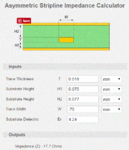HardwareChap
Junior Member level 1
I'm trying to determine the inductance of a track embedded within a PCB to simulate its affect. The layer stack info is below as I've found plenty of tools to determine trace impedance:

The length of the track is 77 mm. How do I get from the stack info provided to an inductance that I could plug into LTSpice to simulate?

The length of the track is 77 mm. How do I get from the stack info provided to an inductance that I could plug into LTSpice to simulate?

